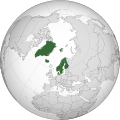Åland
Åland Ahvenanmaa | |
|---|---|
| Region of Åland Landskapet Åland (Swedish) Ahvenanmaan maakunta (Finnish) | |
| Anthem: "Ålänningens sång" (Swedish) (English: "Song of the Ålander") | |
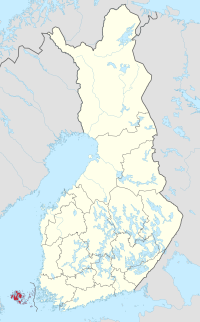 Location of Åland within Finland | |
| Country | Finland |
| Autonomy granted | 7 May 1920[1] |
| First Regional Assembly (Autonomy Day) | 9 June 1922[2][3] |
| EU accession | 1 January 1995 |
| Capital and largest city | Mariehamn 60°07′N 019°54′E / 60.117°N 19.900°E |
| Official languages | Swedish |
| Demonym(s) |
|
| Government | Devolved parliamentary autonomous region |
• Governor | Marine Holm-Johansson |
• Premier | Katrin Sjögren |
• MP | Mats Löfström |
| Legislature | Lagting |
| Area | |
• Total | 1,580[4] km2 (610 sq mi) (unranked) |
| Highest elevation | 129.1 m (423.6 ft) |
| Population | |
• 2020 estimate | 30,129[5] (223rd) |
• Density | 19.07/km2 (49.4/sq mi) |
| GDP (PPP) | 2007 estimate |
• Total | $1.563 billion[6] |
• Per capita | $55,829 |
| GDP (nominal) | 2020 estimate |
• Total | €1.1 billion |
• Per capita | €36,200[7] |
| HDI (2017) | 0.900[8] very high |
| Currency | Euro (€) (EUR) |
| Time zone | UTC+02:00 (EET) |
• Summer (DST) | UTC+03:00 (EEST) |
| Date format | dd.mm.yyyy |
| Driving side | Right |
| Calling code | +358 18 |
| ISO 3166 code | |
| Internet TLD | .ax |
| Website | www.aland.ax |
Åland (/ˈoʊlɑːnd/ OH-lahnd,[9]Swedish: [ˈǒːland] ⓘ; Finnish: Ahvenanmaa) is an autonomous and demilitarised region of Finland. Receiving its autonomy by a 1920 decision of the League of Nations,[1] it is the smallest region of Finland by both area (1,580 km2) and population (30,129), constituting 0.51% of Finland's land area and 0.54% of its population. Its only official language is Swedish and the capital city is Mariehamn.
Åland is situated in a Finnish archipelago, called the Åland Islands, at the entrance to the Gulf of Bothnia in the Baltic Sea. It comprises Fasta Åland, on which 90% of the population resides,[10] and about 6,500 skerries and islands to its east,[11] of which about 60–80 are inhabited. Fasta Åland is separated from the coast of Roslagen in Sweden by 38 kilometres (20+1⁄2 nautical miles) of open water to the west. In the east, the Åland archipelago is contiguous with the Finnish archipelago. Åland's only land border is located on the uninhabited skerry of Märket, which it shares with Sweden.[12] From Mariehamn, there is a ferry distance of about 160 kilometres (86 nautical miles) to Turku, a coastal city of mainland Finland, and also to Stockholm, the capital of Sweden.
Åland's autonomous status means that those provincial powers normally exercised by representatives of the central Finnish Government are largely exercised by its own government. The current demilitarised, neutral position of Åland dates back to the Paris Peace Treaty after the Åland War in the 1850s.[13]
Autonomy
The autonomous status of Åland was affirmed by a decision made by the League of Nations in 1921 following the Åland Islands dispute. It was reaffirmed within the treaty admitting Finland to the European Union. By law, Åland is politically neutral and entirely demilitarised, and residents are exempt from conscription to the Finnish Defence Forces. Åland was granted extensive autonomy by the Parliament of Finland in the Act on the Autonomy of Åland of 1920, which was later replaced by new legislation of the same name in 1951 and 1991. The constitution of Finland defines a "constitution of Åland" by referring to this act. Åland remains exclusively Swedish-speaking by this act.[14] Although a referendum to join the European Union had been held in mainland Finland on 16 October 1994, Åland held a separate vote on 20 November as they were a separate customs jurisdiction. EU membership was approved by 73.64% of voters.[15] In connection with Finland's admission to the European Union, a protocol was signed concerning Åland that stipulates, among other things, that provisions of the European Community Treaty shall not force a change of the existing restrictions for foreigners (i.e., persons who do not enjoy "home region rights"—hembygdsrätt—in Åland) to acquire and hold real property or to provide certain services.[16]
Etymology
Åland's hypothetical name in the Proto-Norse language was *Ahvaland. The Proto-Germanic stem ahwō is related to the Latin word for water, aqua. In Swedish, this toponym first developed into Áland and eventually into Åland, literally 'river land'—even though rivers are not a prominent feature of Åland's geography. The Finnish and Estonian names of the area, Ahvenanmaa and Ahvenamaa ("perch-land", from Finnish ahven, for the type of fish), are believed to preserve another form of the old name.[17]
There are several theories about the origin of the Finnic word Ahvenanmaa, varying from it being a Finnish variant of the Swedish Åland, it being the original name that the toponym Åland derived from, and it having formed independently.[18]
The official name, Landskapet Åland, means "the Region of Åland"; landskap is cognate to English landscape.
History

Members of the Neolithic Comb Ceramic culture started settling the archipelago some 7000 years ago, after the islands had begun to re-emerge from the sea after being pushed down by the weight of the continental ice of the latest ice-age. Two Neolithic cultures met on Åland: the Comb Ceramic culture and the later Pit-Comb Ware culture which spread from the west.[19]
Stone Age and Bronze Age people obtained food by hunting seals and birds, fishing, and gathering plants. They also started agriculture early on. From the Iron Age, Åland has six hillforts. From the Viking age there are over 380 documented burial sites.[19]
Construction of the Kastelholm Castle began in the 1380s. In 1505 it was captured by the Danish naval officer Soren Norby. In 1665 and 1668 the Kastelholm witch trials took place.[citation needed]
The coat of arms of Åland was originally to be granted to the Swedish island province of Öland in 1560; the two had been mixed up by mistake. It displays a golden red deer (which does not live in Åland) on a blue field.[20] This is traditionally surmounted by a comital coronet of the elder Swedish style.[21]
Along with Finland, Åland formed part of the territory ceded to Russia by Sweden under the Treaty of Fredrikshamn in September 1809. As a result, they became part of the newly established Grand Duchy of Finland that existed until 1917. During negotiations, Sweden failed to secure a provision that the islands not be fortified.
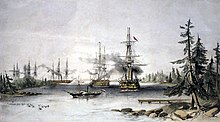
In 1832, Russian Empire started to fortify the islands, with the great fortress of Bomarsund. In 1854, as part of the campaign in the Baltic during the Crimean War against Russia, a combined British and French force of warships and marines captured and destroyed the fortress during the Åland War. The 1856 Treaty of Paris demilitarised the entire Åland archipelago.[13] However, during World War I, Russia remilitarised the islands and began constructing fortifications to prevent a possible German invasion.[22]
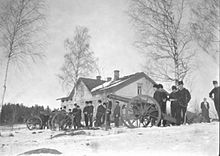
During the Finnish Civil War, in 1918, Swedish troops intervened as a peacekeeping force between the Russian troops stationed on the islands and "White" and "Red" Finnish troops who came from Finland over the frozen sea. Within weeks, the Swedish troops gave way to German troops who occupied Åland at the request of the "White" (conservative) Senate of Finland. The only remarkable battle fought in Åland during the civil war included the Battle of Godby near the village of Godby in Finström.[23]

After 1917, the residents of Åland worked towards having them ceded to Sweden. In 1919 96.4% of the voters in Åland signed a petition for secession from Finland and for integration with Sweden, with over 95% in favour.[24] Swedish nationalist sentiments had strengthened particularly as a result of the anti-Swedish tendencies in Finland and as a result of Finnish nationalism fueled by Finland's struggle to retain its position as an autonomous grand duchy due to beginning of country's active Russification.[25] The conflict between the Swedish-speaking minority and the Finnish-speaking majority on the Finnish mainland, prominent in Finnish politics since the 1840s, contributed to the apprehension of the Åland population about a future within Finland.
Finland, however, declined to cede the islands and instead offered the islanders an autonomous status. Nevertheless, the residents did not approve the offer, and in 1921 the dispute over the islands went before the newly formed League of Nations. The latter decided that Finland should retain sovereignty over the province, but that Åland should be made an autonomous territory.[26] One of the important proponents of a diplomatic solution to the case was Nitobe Inazō, who was one of the Under-Secretaries General of the League and the director of the International Bureaux Section, in charge of the International Committee on Intellectual Cooperation.[27] The Åland convention of 20 October 1921, signed by Sweden, Finland, Germany, the United Kingdom, France, Italy, Denmark, Poland, Estonia, and Latvia, was the first international agreement achieved by the League.[28] Thus, Finland was obliged to ensure the residents of Åland the right to maintain the Swedish language, as well as their own culture and local traditions. The convention of 1921 established the neutral status of Åland by international treaty, prohibiting the placing of military installations or forces on the islands.[29] Åland's Regional Assembly convened for its first plenary session in Mariehamn on 9 June 1922;[2] today, the day is celebrated as Self-Government Day of Åland.[3]
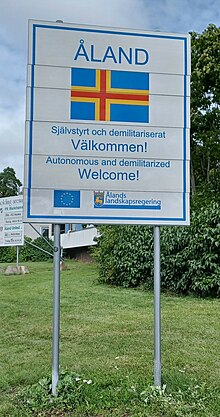
Because of the condition of neutrality under the 1921 Convention, the islanders enjoyed safety at sea during World War II, as their merchant fleet sailed both for the Allied countries and for Nazi Germany. Consequently, Åland shipping was not generally attacked, as the various military forces rarely knew which cargo was being carried or to whom.[citation needed]
Finland marked the 150th anniversary of the demilitarisation of Åland by issuing a high-value commemorative coin, the €5 150th Anniversary of Demilitarisation of Åland commemorative coin, minted in 2006. The obverse depicts a pine tree, a typical feature of Åland. The reverse features a boat's stern and rudder, with a dove perched on the tiller, a symbol of 150 years of peace.[citation needed]
Government and politics
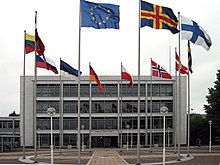
Åland is governed according to the Act on the Autonomy of Åland and international treaties. These laws guarantee the region's autonomy from Finland, which has ultimate sovereignty over them, as well as a demilitarised status. The Government of Åland, or Landskapsregering, answers to the Parliament of Åland, or Lagting, in accordance with the principles of parliamentarism.[14]
Åland has its own flag and has issued its own postage stamps since 1984.[30] It runs its own police force, and is an associate member of the Nordic Council.[31] Åland is demilitarised, and the population is exempt from conscription. Although Åland's autonomy preceded the creation of the regions of Finland, the autonomous government of Åland also has responsibility for the functions undertaken by Finland's regional councils. Åland Post provides postal services to the islands, and is a member of the Small European Postal Administration Cooperation. Åland is considered a separate entity for amateur radio purposes and have their own call sign prefixes granted by Finland: OH0, OF0 and OG0 (last character is zero).[32]
Åland is guaranteed representation in the Finnish parliament, to which they elect one representative. Åland also has a different system of political parties from the mainland.
Homeschooling, which has been effectively banned in Sweden since 2011, is allowed by the Finnish government. Due to the islands' proximity to Sweden and because they are Swedish-speaking, a number of Swedish homeschooling families have moved from the Swedish mainland to Åland, including Jonas Himmelstrand, the chairman of the Swedish association for homeschooling.[33]
After a reform of the electoral law, Åland was to introduce internet voting in 2019 for expat voters in the parliamentary elections, considering opening the use of the same system for the next elections (2023) to all the voters.[34] However, its use was cancelled at the last minute due to a lack of evidence of the trustability of the system.[35]
Åland's parties include a separatist party called the Future of Åland (Swedish: Ålands Framtid), whose main program includes driving autonomous Åland into a completely independent state.[36][37]
Åland and the EU
Åland held its own referendum on membership of the European Union on 20 November 1994. A majority of Ålanders voted in favour of membership, and it followed Finland into the Union in 1995. A special Åland protocol regulates Åland's position within the EU. It has some important exceptions, concerning the right of non-Ålanders to own real estate and the right of non-Ålandic companies to establish themselves in the region, and concerning EU tax legislation. The last item's derogation means that Åland is considered a third country for tax purposes, which has had the most important effect of allowing the profitable sale of tax-exempt goods on ferries to and from Sweden and Finland to continue.[citation needed]
Administration

The State Department of Åland represents the Finnish central government and performs many administrative duties. It has a somewhat different function from the other Regional Administrative Agencies, owing to its autonomy. Before 2010, the state administration was handled by the Åland State Provincial Office.
The State Department is led by the Governor of Åland, who also serves as a representative of the Finnish State in Åland. The Governor is responsible for opening the Lagting on behalf of the President of the Republic. The Governor is appointed by the President in consensus with the Speaker of the Lagting. If consensus can't be reached the Lagting shall nominate 5 individuals of which the President shall appoint 1.[38]
The Governors of Åland are listed below:
- William Isaksson (1918–1922)
- Wilhelm Fagerlund (1922–1938)
- Torsten Rothberg (1938-1938)
- Walter Johansson (acting 1938)
- Ruben Österberg (1938–1945)
- Herman Koroleff (1945–1954)
- Tor Brenning (1954–1972)
- Martin Isaksson (1972–1982)
- Henrik Gustafsson (1982–1999)
- Peter Lindbäck (1999–2023)
- Marine Holm-Johansson (2023–present)
Åland has its own postal administration but still uses the Finnish five-digit postal code system, using the number range 22000–22999, with the prefix AX. The lowest numbered postal code is for the capital Mariehamn, AX 22100, and the highest AX 22950 for Jurmo.
Municipalities
Åland contains 16 municipalities. Over forty percent of all inhabitants live in Mariehamn, the capital.[39]
 Mariehamn
Mariehamn
- Population: 11,888

- Population: 11,888
 Jomala
Jomala
- Population: 5,768

- Population: 5,768
 Finström
Finström
- Population: 2,637

- Population: 2,637
 Lemland
Lemland
- Population: 2,140

- Population: 2,140
 Saltvik
Saltvik
- Population: 1,775

- Population: 1,775
 Hammarland
Hammarland
- Population: 1,647

- Population: 1,647
 Sund
Sund
- Population: 1,007

- Population: 1,007
 Eckerö
Eckerö
- Population: 952

- Population: 952
 Föglö
Föglö
- Population: 510

- Population: 510
 Geta
Geta
- Population: 516

- Population: 516
 Vårdö
Vårdö
- Population: 467

- Population: 467
 Brändö
Brändö
- Population: 445

- Population: 445
 Lumparland
Lumparland
- Population: 364

- Population: 364
 Kumlinge
Kumlinge
- Population: 277

- Population: 277
 Kökar
Kökar
- Population: 226

- Population: 226
 Sottunga
Sottunga
- Population: 115

- Population: 115
Population as 31 October 2024.[40]
Geography


Åland occupies a position of strategic importance, as it commands one of the entrances to the port of Stockholm, as well as the approaches to the Gulf of Bothnia, in addition to being situated near the Gulf of Finland.
The Åland archipelago includes nearly three hundred habitable islands, of which about 60–80 are inhabited; the remainder are merely some 6,200 skerries and desolate rocks.[11] The archipelago is connected to the Åboland archipelago in the east (Finnish: Turunmaan saaristo, Swedish: Åbolands skärgård)—the archipelago adjacent to the southwest coast of Finland. Together they form the Archipelago Sea. To the west of Åland is the Sea of Åland and to the north is the Bothnian Sea.
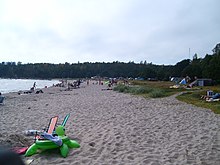
The surface of the islands is generally rocky and the soil thin due to glacial stripping at the end of the most recent ice age.[11] The islands also contain many meadows that are home to many different kinds of insects, such as the Glanville fritillary butterfly.
Åland's landmass occupies a total area of 1,527 square kilometres (589+1⁄2 sq mi).[42] Ninety percent of the population live on Fasta Åland, which is also the site of the capital town of Mariehamn. Fasta Åland is the largest island in the archipelago. Its area is difficult to estimate due to its irregular shape and coastline, but estimates range from 740 square kilometres[11] to 879 square kilometres[43] to over 1,010 square kilometres, depending on what is included or excluded. There are several harbours.
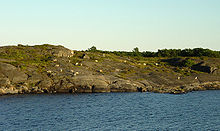
During the Åland Islands dispute, the parties sought support from different maps of the area. On the Swedish map, the most densely populated main island dominated, and many skerries were left out. On the Finnish map, many smaller islands or skerries were, for technical reasons, given a slightly exaggerated size. The Swedish map made the islands appear to be closer to the mainland of Sweden than to Finland; the Finnish map stressed the continuity of the archipelago between the main island and mainland Finland, while a greater gap appeared between the islands and the archipelago on the Swedish side. One consequence is the often repeated number of "over 6,000" skerries that was given authority by the outcome of the arbitration.[citation needed]
Many animals that live in the islands are not native. Animals such as elk and other species of deer were introduced in the 20th century.
Climate
Åland has a humid continental climate (Dfb) that is influenced by its maritime position, especially in summer. While summers are cooler than on both the Swedish and Finnish mainland, winters see little difference to the adjacent parts of Sweden and are only narrowly milder than in mainland Finland.
| Climate data for Mariehamn Airport (normals 1991–2020, extremes 1914–present) | |||||||||||||
|---|---|---|---|---|---|---|---|---|---|---|---|---|---|
| Month | Jan | Feb | Mar | Apr | May | Jun | Jul | Aug | Sep | Oct | Nov | Dec | Year |
| Record high °C (°F) | 10.9 (51.6) |
10.5 (50.9) |
17.0 (62.6) |
21.1 (70.0) |
27.1 (80.8) |
29.4 (84.9) |
31.3 (88.3) |
30.7 (87.3) |
24.8 (76.6) |
19.0 (66.2) |
16.6 (61.9) |
11.1 (52.0) |
31.3 (88.3) |
| Mean daily maximum °C (°F) | 1.0 (33.8) |
0.4 (32.7) |
3.1 (37.6) |
8.0 (46.4) |
13.4 (56.1) |
17.5 (63.5) |
20.8 (69.4) |
20.0 (68.0) |
15.5 (59.9) |
9.6 (49.3) |
5.2 (41.4) |
2.5 (36.5) |
9.8 (49.6) |
| Daily mean °C (°F) | −1.3 (29.7) |
−2.3 (27.9) |
−0.2 (31.6) |
3.8 (38.8) |
8.9 (48.0) |
13.3 (55.9) |
16.8 (62.2) |
16.1 (61.0) |
11.8 (53.2) |
6.8 (44.2) |
3.2 (37.8) |
0.4 (32.7) |
6.4 (43.5) |
| Mean daily minimum °C (°F) | −4.3 (24.3) |
−5.5 (22.1) |
−3.7 (25.3) |
−0.1 (31.8) |
4.0 (39.2) |
8.6 (47.5) |
12.2 (54.0) |
11.6 (52.9) |
7.8 (46.0) |
3.5 (38.3) |
0.6 (33.1) |
−2.5 (27.5) |
2.7 (36.9) |
| Record low °C (°F) | −32.3 (−26.1) |
−32.9 (−27.2) |
−25.0 (−13.0) |
−18.9 (−2.0) |
−6.5 (20.3) |
−3.2 (26.2) |
0.1 (32.2) |
−0.5 (31.1) |
−6.7 (19.9) |
−11.8 (10.8) |
−20.0 (−4.0) |
−28.9 (−20.0) |
−32.9 (−27.2) |
| Average precipitation mm (inches) | 53 (2.1) |
35 (1.4) |
38 (1.5) |
31 (1.2) |
35 (1.4) |
53 (2.1) |
52 (2.0) |
76 (3.0) |
61 (2.4) |
70 (2.8) |
71 (2.8) |
59 (2.3) |
634 (25) |
| Average precipitation days | 17 | 13 | 12 | 9 | 10 | 10 | 9 | 13 | 12 | 16 | 17 | 17 | 155 |
| Mean monthly sunshine hours | 39 | 74 | 130 | 207 | 297 | 296 | 312 | 235 | 163 | 91 | 41 | 26 | 1,911 |
| Source 1: FMI climatological normals for Finland 1991–2020[44] | |||||||||||||
| Source 2: record highs and lows 1961– present[45] | |||||||||||||
Economy
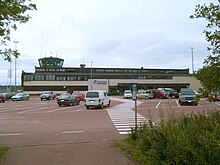

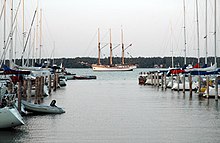
Åland's economy is heavily dominated by shipping, trade and tourism. Shipping represents about 40% of the economy, with several international carriers owned and operated from Åland. Most companies aside from shipping are small, with fewer than ten employees. Farming and fishing are important in combination with the food industry. A few high-profile technology companies contribute to a prosperous economy. Wind power is rapidly developing, aiming at reversing the direction in the cables to the mainland in coming years. In December 2011, wind power accounted for 31.5% of Åland's total electricity usage.[citation needed]
The main ports are the Western Harbour of Mariehamn (south), Berghamn (west) and Långnäs on the eastern shore of the Main Island. Fasta Åland has the only four highways in Åland: Highway 1 (from Mariehamn to Eckerö), Highway 2 (from Mariehamn to Sund), Highway 3 (from Mariehamn to Lumparland) and Highway 4 (from Finström to Geta).
Mariehamn served as the base for the last large oceanic commercial sailing-ships in the world. Their final tasks involved bringing Australian wheat to Great Britain, a trade which Åland shipowner Gustaf Erikson kept going until 1947. The ships latterly made only one round-trip from South Australia to Britain per year, (the grain race), after each marathon voyage going back to Mariehamn to lay up for a few months. The ship Pommern, now a museum in Mariehamn, was one of these last vessels.
The abolition of tax-free sales on ferry boats travelling between destinations within the European Union made Finland demand an exception for Åland on the European Union value-added tax rules. The exception allows for maintained tax-free sales on the ferries between Sweden and Finland (provided they stop at Mariehamn or Långnäs) and at the airport, but has also made Åland a different tax-zone, meaning that tariffs must be levied on goods brought to the islands. Two million people visit Åland every year – but most of them just for a few hours before the ferry returns again, or the passengers change from one ship to another.[47]
Unemployment was 3.9% in January 2014;[48] the employment rate was 79.8% in 2011 and 84.2% in 2021.[49]

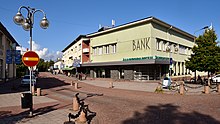
The Finnish State also collects taxes, duties and fees in Åland. In return, the Finnish Government places a sum of money at the disposal of the Åland Parliament. The sum is 0.5% of total Government income, excluding Government loans. If the sum paid to the Finnish state exceeds 0.5%, then any amount above goes back to the Parliament of Åland as "diligence money".[50] In 2010, the amount of taxes paid by Åland Islanders comprised 0.7% of the total taxes paid in Finland.[51]
The euro is the sole legal tender (as with the rest of Finland), although most businesses in Åland unofficially accept the Swedish krona.[52] According to Eurostat, as of 2006 Åland was the 20th-wealthiest of the EU's 268 regions, and the wealthiest in Finland, with a GDP per inhabitant 47% above the EU mean.[53][54]
Bank of Åland is headquartered on the island, and the government of Åland owns Paf, a gambling operator with headquarters in Mariehamn.
The COVID-19 pandemic caused a sharper decrease in the total volume of the economy of Åland than for neighbouring Sweden or Finland. Since the pandemic, the economy of Åland has been on a trajectory of recovery.[55]
Demographics
Ethnicity and language
Most inhabitants speak Swedish (the sole official language) as their first language: 86% in 2021, while less than 5% spoke Finnish. The language of instruction in publicly financed schools is Swedish. (In the rest of Finland, bilingual municipalities provide schooling both in Finnish and in Swedish.) For information about the dialect, see Åland Swedish.
The ethnicity of the Ålanders and the correct linguistic classification of their language remain somewhat sensitive and controversial. Ålanders may be considered either ethnic Swedes or Swedish-speaking Finns, but their language is closer to the Uppländska dialect of Sweden than to Finland Swedish.[citation needed] (See Languages of Sweden.)
Regional citizenship or the right of domicile (hembygdsrätt) is a prerequisite for voting, standing as a candidate for the Legislative Assembly, or owning and holding real estate situated in unplanned areas of Åland.[14]
17.3% of Ålanders have a foreign-background, which is the highest proportion of any region in Finland. Most of them are from Sweden, with 7% of Ålanders having a Swedish-background. There are also sizable Romanian and Latvian communities.[56]
Structure of the population
| Age Group | Male | Female | Total | % |
|---|---|---|---|---|
| Total | 15 039 | 15 198 | 30 237 | 100 |
| 0–4 | 751 | 731 | 1 482 | 4.90 |
| 5–9 | 888 | 855 | 1 743 | 5.76 |
| 10–14 | 897 | 860 | 1 757 | 5.81 |
| 15–19 | 818 | 755 | 1 572 | 5.20 |
| 20–24 | 708 | 524 | 1 232 | 4.07 |
| 25–29 | 816 | 781 | 1 597 | 5.28 |
| 30–34 | 1 008 | 941 | 1 949 | 6.45 |
| 35–39 | 963 | 961 | 1 923 | 6.36 |
| 40–44 | 951 | 944 | 1 895 | 6.27 |
| 45–49 | 1 010 | 958 | 1 967 | 6.51 |
| 50–54 | 1 024 | 1 067 | 2 091 | 6.92 |
| 55–59 | 1 036 | 1 055 | 2 091 | 6.92 |
| 60–64 | 896 | 1 031 | 1 926 | 6.37 |
| 65–69 | 941 | 1 037 | 1 977 | 6.54 |
| 70–74 | 905 | 959 | 1 864 | 6.16 |
| 75–79 | 715 | 714 | 1 429 | 4.73 |
| 80–84 | 397 | 481 | 877 | 2.90 |
| 85–89 | 221 | 330 | 551 | 1.82 |
| 90–94 | 80 | 159 | 239 | 0.79 |
| 95–99 | 19 | 55 | 74 | 0.24 |
| 100+ | 2 | 6 | 8 | 0.03 |
| 0–14 | 2 536 | 2 446 | 4 982 | 16.48 |
| 15–64 | 9 223 | 9 011 | 18 234 | 60.30 |
| 65+ | 3 280 | 3 741 | 7 021 | 23.22 |
Education
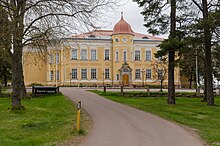
In 2010, there were 22 primary schools in Åland. Eight of them covered both upper and lower secondary schools, two were upper secondary schools and 12 were primary schools (grades 1–6).[58] There exists two places of post-primary studies on the islands: the traditional high school of Ålands lyceum or the Åland vocational high school, which offers a double degree in high school and vocational studies. Of these, Ålands lyceum is a relatively large high school; according to the 2018 statistics of the education administration, as many as 432 high school students studied there.[59] The schools on Åland also include Ålands folkhögskola and other several primary and secondary schools.[60] Åland University of Applied Sciences teaches about 600 students[61] in maritime, mechanical engineering, electrical engineering, IT, finance, hotels, restaurants and health care.[62] The maritime education of Åland are all part of Alandica Shipping Academy.[63]
The education in Åland is similar to that of Finland and the Nordics, and the language of education on Åland is officially Swedish. Finnish language has been a compulsory subject in upper secondary school, but optional in primary school; however, 80 per cent of students have chosen it. In 2006, it was proposed to remove the compulsory Finnish language from upper secondary schools.[64]
Religion

The majority of the population, 70.5%, belongs to the Evangelical Lutheran Church of Finland.[65] Åland contains Finland's oldest Christian churches, including St. Olaf's Church, Jomala, which, dating from the late 13th century, is likely the oldest in Finland.[66] Åland's largest church is the Church of St. John in Sund, dating from shortly after.[67]
Culture
Literature
The most famous writers in Åland are Anni Blomqvist, known for her five-volume Stormskärs-Maja series,[68] Sally Salminen, whose best-known work is the 1936 novel Katrina,[69] and Ulla-Lena Lundberg, who has described her native Kökar. All of these works are set in Åland.
Cinema and television
A 2016 historical drama film Devil's Bride, directed by Saara Cantell, takes place in the 17th century in Åland during the witch hunts.[70] It won the Best Foreign Language Film Award at the Toronto Female Eye Film Festival in 2017.[71] Also, a 2013 drama film Disciple, directed by Ulrika Bengts, is set in Åland.[72][73]
Sport
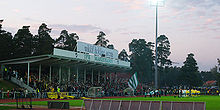
In association football Åland national team competes in the biennial Island Games, which it hosted in 1991 and 2009. Åland also hosted the 1974 and 1977 Women's Nordic Football Championship. Competitions and teams are organised by the Åland Football Association which also organise the Ålands Cup for clubs.
Women's football club Åland United, founded in 2004, and men's IFK Mariehamn are Åland's leading football clubs. IFK play in the Veikkausliiga, Finland's highest football league. Both clubs play at the Wiklöf Holding Arena in Mariehamn.
Other smaller clubs include FC Åland, IF Finströms Kamraterna, IF Fram and Lemlands IF.
Åland hosted the 2017 and 2018 Paf Masters, an annual bonspiel-women's curling tournament hosted in Eckerö.
The Åland Stags is Åland's only rugby union club.
Disc golf is popular in Åland.
Heraldry
The coat of arms of Åland features a golden red deer on a blue field. This is traditionally surmounted by a comital coronet of the elder Swedish style.[21] The arms borne today by Åland were originally by mistake granted to the island province of Öland in 1560, displaying a golden red deer on a blue field.[20]
Notable people



- Sara Holmsten (1713–1795), writer
- Frans Peter von Knorring (1792–1875), social reformer
- Georg August Wallin (1811–1852), professor, explorer and orientalist
- Karl Emanuel Jansson (1846–1874), a painter, primarily of genre scenes
- Robert Mattson (1851–1935), shipowner and businessman.
- Gustaf Erikson (1872–1947), ship-owner, operated a fleet of windjammers
- Joel Pettersson (1892–1937), painter and author
- Atos Wirtanen (1906–1979), politician and journalist
- Sally Salminen (1906–1976), author; nominated for the Nobel Prize in Literature three times.
- Ture Bengtz (1907–1973), a Finnish-American artist with the Boston Expressionist school
- Ville Salminen (1908–1992), film actor and director
- Anni Blomqvist (1909–1990), author and novelist
- Jaakko Suolahti (1918–1987), classical scholar and historian
- Pehr Henrik Nordgren (1944–2008), composer
- Ulla-Lena Lundberg (born 1947), author
- Peter Lindbäck (born 1955, Helsinki), the governor of Åland since 1999
- Stefan Lindfors (born 1962), an industrial & interior designer, film-maker and sculptor.
- Veronica Thörnroos (born 1962), politician, Head of Government of the Åland Islands since 2019
- Jeremy Duns (born 1973), a British author of spy fiction, lives in Åland.[74]
Sport
- Kaarlo Mäkinen (1892–1980), freestyle wrestler, medallist at the 1924 and 1928 Summer Olympics
- Frej Liewendahl (1902–1966), track and field athlete; team gold medallist at the 1924 Summer Olympics
- Daniel Sjölund (born 1983), former footballer with 380 club caps and 37 with Finland
- Adelina Engman (born 1994), football player, 84 games with Finland women
- Robert Helenius (born 1984), heavyweight boxer, lives in Åland
- Johan Hellström (1907–1989), boxer who competed in the 1928 Summer Olympics.
- Annica Sjölund (born 1985), football player, 67 games with Finland women
See also
References
- ^ a b Hurst Hannum (1993). "Agreement between Sweden and Finland Relating to Guarantees in the Law of 7 May 1920 on the Autonomy of the Aaland Islands". Basic Documents on Autonomy and Minority Rights. Martinus Nijhoff Publishers. p. 141. ISBN 0-7923-1977-X. Archived from the original on 7 July 2023. Retrieved 11 October 2015.
- ^ a b "Ahvenanmaa pähkinänkuoressa". Ahvenanmaa – ahaa! (in Finnish). 2007. p. 3.
- ^ a b "Ahvenanmaan historiaa lyhyesti". Pohjola Norden (in Finnish). Archived from the original on 29 January 2016. Retrieved 10 December 2020.
- ^ "Ennakkoväkiluku sukupuolen mukaan alueittain, helmikuu.2016". Pxnet2.stat.fi. Archived from the original on 10 April 2016. Retrieved 31 March 2016.
- ^ Tilastokeskus. "Population". tilastokeskus.fi. Archived from the original on 10 July 2006. Retrieved 9 August 2021.
- ^ "Välkommen till ÅSUB! – Ålands statistik- och utredningsbyrå". Asub.ax. Archived from the original on 15 November 2016. Retrieved 26 October 2017.
- ^ "Facts about Åland | Nordic cooperation". norden.org. Archived from the original on 9 August 2021. Retrieved 9 August 2021.
- ^ "Sub-national HDI – Area Database – Global Data Lab". hdi.globaldatalab.org. Archived from the original on 23 September 2018. Retrieved 13 September 2018.
- ^ "Aland". Merriam-Webster.com Dictionary. Merriam-Webster. Retrieved 31 December 2024.
- ^ "The Aland Islands". Osterholm.info. 9 May 2012. Archived from the original on 9 May 2012. Retrieved 26 October 2017.
{{cite web}}: CS1 maint: bot: original URL status unknown (link) - ^ a b c d Scheffel, Richard L.; Wernet, Susan J., eds. (1980). Natural Wonders of the World. United States of America: Reader's Digest Association, Inc. p. 3. ISBN 0-89577-087-3.
- ^ An account of the border on Märket and how it was redrawn in 1985 appears in Hidden Europe Magazine, 11 (November 2006) pp. 26–29, ISSN 1860-6318
- ^ a b "Uneasy Sweden and the Menace of Prussianism; An Analysis of the Scandinavian Situation in View of Kaiser's Reported Ambition to Make the Baltic a German Lake" (PDF). Query.nytimes.com. Archived (PDF) from the original on 28 August 2021. Retrieved 26 October 2017.
- ^ a b c "Act on the Autonomy of Åland" (PDF). Finlex. 1991. Archived (PDF) from the original on 16 February 2021. Retrieved 25 January 2017.
- ^ Åland-Inseln (Finnland), 20. November 1994 : Beitritt zur EU Archived 16 July 2015 at the Wayback Machine Direct Democracy
- ^ "Åland in the European Union". Europe Information. Ministry for Foreign Affairs of Finland. 2013. p. 7. Archived from the original on 21 August 2016. Retrieved 25 January 2017.
- ^ Virrankoski, Pentti (2001). Suomen historia. Ensimmäinen osa. SKS. ISBN 951-746-321-9. p. 59.
- ^ Lars Hulden (2001) Finlandssvenska bebyggelsenamn; Svenska litteratursällskapet i Finland. ISBN 951-583-071-0.
- ^ a b "åland, the history". Aland Museum. Archived from the original on 23 January 2017. Retrieved 15 January 2016.
- ^ a b Nevéus, Clara; Wærn, Jacques de (1992). Ny Svensk Vapenbok (in Swedish). Stockholm, Sweden: Streiffert & Co Bokförlag HB. p. 32. ISBN 91-7886-092-X.
- ^ a b "Maakuntien vaakunat" (in Finnish). Archived from the original on 21 February 2007. Retrieved 19 July 2013.
- ^ Eriksson, Sussanne (1993). Åland Kort och gott [Åland in short] (in Swedish). Ålands landskapsstyrelse och Ålands lagting. ISBN 9518946000.
- ^ Harjula, Mirko (2010). Itämeri 1914–1921: Itämeren laivastot maailmansodassa sekä Venäjän vallankumouksissa ja sisällissodassa (in Finnish). Helsinki: Books on Demand. ISBN 978-952-49838-3-9.
- ^ ch, Beat Müller, beat (at-sign) sudd (dot) (June 1919). "Åland-Inseln (Finnland), ??. Juni 1919 : Anschluss an Schweden [in German]". Sudd.ch. Archived from the original on 13 March 2013. Retrieved 26 October 2017.
{{cite web}}: CS1 maint: multiple names: authors list (link) - ^ "The Birth of Finnish Nationalism". Finland Divided. 21 September 2016. Archived from the original on 30 April 2023. Retrieved 11 September 2023.
- ^ Rudmose-Brown, Robert Neal (1922). . Encyclopædia Britannica. Vol. 30 (12th ed.).
- ^ Margery Post Abbott, Mary Ellen Chijioke, Pink Dandelion & John William Oliver: Historical Dictionary of the Friends (Quakers), p. 246. Scarecrow Press, 2011. ISBN 0810868571.
- ^ F. S. Northedge, The League of Nations: Its Life and Times, 1920–1946 (Holmes & Meier, 1986, ISBN 978-0-7185-1316-0), pp 77, 78
- ^ Elgán, Elisabeth (2015). Historical Dictionary of Sweden. Rowman & Littlefield. p. 26. ISBN 9781442250710.
- ^ "Product catalogue". Aland Stamps. Archived from the original on 11 February 2017. Retrieved 10 February 2017.
- ^ "The 2007 Session of the Nordic Council". European Tribune. 2007. Archived from the original on 2 February 2017. Retrieved 10 February 2017.
- ^ "International Prefixes". Radio Society of Great Britain. Archived from the original on 26 October 2017. Retrieved 10 February 2017.
- ^ "Allt fler hemundervisare flyttar till Åland". Ålandstidningen. Archived from the original on 23 February 2017. Retrieved 12 August 2015.
- ^ Krimmer, Robert; Duenas-Cid, David; Krivonosova, Iuliia; Serrano, Radu Antonio; Freire, Marlon; Wrede, Casper. "Krimmer, R., Duenas-Cid, D., Krivonosova, I., Serrano, R. A., Freire, M., & Wrede, C. (2019, September 27). Nordic Pioneers: facing the first use of Internet Voting in the Åland Islands (Parliamentary Elections 2019)". doi:10.31235/osf.io/5zr2e. S2CID 242767959. Archived from the original on 7 July 2023.
{{cite journal}}: Cite journal requires|journal=(help) - ^ Duenas-Cid, David; Krivonosova, Iuliia; Serrano, Radu; Freire, Marlon; Krimmer, Robert (7 May 2020). "Tripped at the Finishing Line: The Åland Islands Internet Voting Project". In Krimmer, Robert; Volkamer, Melanie; Beckert, Bernhard; Küsters, Ralf; Kulyk, Oksana; Duenas-Cid, David; Solvak, Mihkel (eds.). Electronic Voting. Lecture Notes in Computer Science. Vol. 12455. Springer International Publishing. pp. 36–49. doi:10.1007/978-3-030-60347-2_3. ISBN 978-3-030-60346-5. S2CID 221911723. Archived from the original on 7 May 2021. Retrieved 7 May 2021 – via Springer Link.
- ^ "Viva Åland! Independence Dream Not Dead, But More Autonomy Comes First". Archived from the original on 20 January 2021. Retrieved 25 March 2021.
- ^ "Wednesday's papers: Åland's separatists take heart, housing market warning and pig farm vaccinations". Yle Uutiset. 4 October 2017. Archived from the original on 11 April 2021. Retrieved 25 March 2021.
- ^ url=https://www.finlex.fi/fi/laki/ajantasa/1991/19911144
- ^ "The special status of Åland". Ministry for Foreign Affairs of Finland. Archived from the original on 23 July 2021. Retrieved 6 July 2021.
- ^ "Statistical Yearbook ÅLAND" (PDF). Archived from the original (PDF) on 24 July 2020. Retrieved 22 December 2019.
- ^ Guide, Copyright-The World Beach. "Degersand Beach / Finland". World Beach Guide. Archived from the original on 9 July 2021. Retrieved 5 July 2021.
- ^ "Statistical Yearbook of Finland 2016" (PDF). Stat.fi. p. 505. Archived from the original (PDF) on 11 February 2017. Retrieved 7 February 2017.
- ^ Europe, Council of (1 January 2012). Biodiversity and Climate Change: Reports and Guidance Developed Under the Bern Convention. Council of Europe. p. 251. ISBN 9789287170590. Archived from the original on 7 July 2023. Retrieved 21 October 2020.
- ^ "FMI normals 1991–2020" (PDF). fmi.fi. Archived (PDF) from the original on 7 July 2023. Retrieved 26 April 2016.
- ^ "FMI open data". FMI. Archived from the original on 1 October 2018. Retrieved 26 April 2016.
- ^ "SUOMEN MAAKUNTIEN ILMASTO" (PDF). Archived (PDF) from the original on 19 March 2021. Retrieved 3 February 2023.
- ^ Åland: many travellers, far fewer overnighters Archived 15 August 2021 at the Wayback Machine, Nordic Labour Journal, 27 June 2019
- ^ "Archived copy" (PDF). Archived from the original (PDF) on 12 August 2014. Retrieved 12 August 2014.
{{cite web}}: CS1 maint: archived copy as title (link) - ^ "Saved query for employment statistics 2011–2021". stat.fi.[permanent dead link]
- ^ "Lagtingets uppgifter". Lagtinget.ax. 22 October 2015. Archived from the original on 2 October 2015. Retrieved 26 October 2017.
- ^ "Om landskapet Åland tillkommande skattegottgörelse för 2010" (PDF). 13 March 2013. Archived from the original on 13 March 2013. Retrieved 26 October 2017.
{{cite web}}: CS1 maint: bot: original URL status unknown (link) - ^ Symington, Andy; Bain, Carolyn; Bonetto, Cristian; Ham, Anthony & Kaminski, Anna (2013), Scandinavia, Lonely Planet
- ^ "Europe's Regions" (PDF). 20 August 2012. Archived from the original on 20 August 2012. Retrieved 26 October 2017.
{{cite web}}: CS1 maint: bot: original URL status unknown (link) - ^ "Ahvenanmaa on EU:n 20. vaurain alue". Helsingin Sanomat. 19 February 2009. Archived from the original on 8 November 2011. Retrieved 19 July 2009.
- ^ "Ekonomisk översikt hösten 2020 | Ålands statistik- och utredningsbyrå" (in Swedish). Asub.ax. 9 October 2020. Archived from the original on 22 May 2022. Retrieved 30 June 2022.
- ^ "Väestö 31.12. Muuttujina Maakunta, Taustamaa, Sukupuoli, Ikä, Syntyperä, Vuosi ja Tiedot". Archived from the original on 15 April 2022. Retrieved 1 September 2022.
- ^ "Demographic and Social Statistics". UNSD. 3 April 2023. Archived from the original on 27 March 2023. Retrieved 25 June 2023.
- ^ "Grundskolor på Åland" (in Swedish). Ålands kommunförbund. Archived from the original on 6 March 2016. Retrieved 24 November 2020.
- ^ "Lukiokoulutuksen oppilaat". vipunen.fi (in Finnish). Opetushallinnon tilastopalvelu Vipunen. Archived from the original on 29 November 2020. Retrieved 24 November 2020.
- ^ "Skolor på Åland | Utbildningsbyrån". utbildning.ax. Archived from the original on 18 November 2021. Retrieved 22 November 2021.
- ^ "Info om Högskolan på Åland". ha.ax (in Swedish). Archived from the original on 19 April 2021. Retrieved 24 November 2020.
- ^ "Studera på Åland" (in Swedish). AMS – arbetsmarknad – Studierna. Archived from the original on 28 January 2016. Retrieved 24 November 2020.
- ^ "ASA | Alandica Shipping Academy". ASA (in Swedish). Archived from the original on 21 June 2020. Retrieved 22 November 2021.
- ^ "Pakkosuomi uhan alla Ahvenanmaalla". Sveriges Radio. Sveriges Radio Sisuradio. 2006. Archived from the original on 30 August 2017. Retrieved 24 November 2020.
- ^ Key figures on population by region in 1990–2020 Archived 12 December 2019 at the Wayback Machine Statistics Finland
- ^ "Saint Olaf's Church". Alluring World. 8 July 2017. Archived from the original on 19 September 2021. Retrieved 19 May 2022.
- ^ "Churches in Åland". Muuka.com. Archived from the original on 6 June 2017. Retrieved 26 October 2017.
- ^ "Anni Blomqvist". authorscalendar.info. Archived from the original on 18 January 2020. Retrieved 31 July 2020.
- ^ "Romanen Katrina var bara början – Sally Salminen var så mycket mer" säger Ulrika Gustafsson som skrivit en biografi över småbrukardottern från Vårdö som blev författare mot alla odds Archived 20 October 2020 at the Wayback Machine (in Swedish)
- ^ "Devil's Bride – Brosmark". Brosmark.com. Archived from the original on 2 October 2020. Retrieved 31 July 2020.
- ^ "Best Foreign Feature". Elinpetersdottir.com. June 2017. Archived from the original on 13 August 2020. Retrieved 31 July 2020.
- ^ "Kotiapulaisesta kirjailijaksi" (in Finnish). Uusi Suomi. 2008. Archived from the original on 5 March 2016. Retrieved 31 July 2020.
- ^ "Oppipoika (2013)". Elokuvauutiset (in Finnish). 25 September 2014. Archived from the original on 5 November 2020. Retrieved 31 July 2020.
- ^ "The Bulletin at 60: Thriller writer Jeremy Duns enjoyed "digging deep" into Belgian life during his Bulletin years". 6 October 2022. Archived from the original on 6 December 2022. Retrieved 6 July 2023.
Further reading
- Barros, James – The Aland Islands Question: Its Settlement by the League of Nations.[1]
- Mead, W. R. - Saltvik: Studies from an Aland Parish.[2]
- Sederholm, J. J. - On Migmatites and Associated Pre-Cambrian Rocks of Southwestern Finland, Part III: The Aland Islands.[3]
External links
 Media related to Åland at Wikimedia Commons
Media related to Åland at Wikimedia Commons Åland travel guide from Wikivoyage
Åland travel guide from Wikivoyage Wikimedia Atlas of Åland
Wikimedia Atlas of Åland- Official website (in English)
- Government of Åland (in Swedish)
- B7 Baltic Islands Network Archived 13 February 2008 at the Wayback Machine
- The example of Åland, autonomy as a minor protector The Åland example: autonomy protects a minority
- Ålandstidningen (local newspaper)
60°15′N 20°22′E / 60.250°N 20.367°E
- ^ Upton, A. F. (July 1970). "Review". The English Historical Review. 85 (336). Oxford University Press: 631. doi:10.1093/ehr/lxxxv.336.631-a. JSTOR 563263.
- ^ Coleman, Alice (December 1964). "Review". The Geographical Journal. 130 (4). Blackwell Publishing on behalf of The Royal Geographical Society (with the Institute of British Geographers): 571–572. doi:10.2307/1792320. JSTOR 1792320.
- ^ Grogan, Robert (October–November 1935). "Review". The Journal of Geology. 43 (7). The University of Chicago Press: 784. Bibcode:1935JG.....43..784G. doi:10.1086/624372. JSTOR 30057950.





